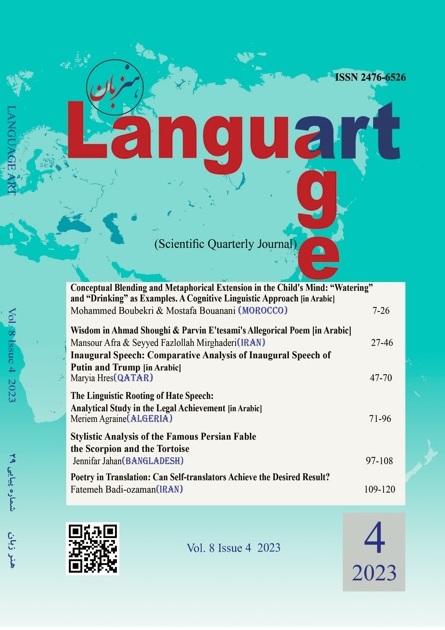Conceptual Blending and Metaphorical Extension in the Child's Mind: “Watering” and “Drinking” as Examples. A Cognitive – Linguistic Approach
DOI:
https://doi.org/10.22046/LA.2023.19Keywords:
Conceptual Metaphor, Cognitive Linguistic, Conceptual Blending, Metaphorical AcquisitionAbstract
This study examines the relationship between conceptual blending and metaphorical extension in the child’s mind. This is based on a field study that tracked the metaphorical behaviour of a random sample of children consisting of (64) participants (male and female equally), ranging in age from (4) to (7) years. The participants are divided into four categories: preschoolers and First-year elementary school learners in the private and public sectors of the Moroccan educational context. For the purpose above, we have built a perceptual–linguistic test that measures the relationship between conceptual blending and metaphorical extension of the child in general: taking both watering and drinking as examples. at the same time, reveals which paths this metaphorical blending may take more specifically. All this with the objective to approach the processes of the production of metaphors and their representation in the mind of this group of participants, and to describe the cognitive mechanisms behind these mental operations that show the way the metaphor is treated in various dimensions: psychological, conceptual, and perceptual. The study concluded that conceptual blending was the basis of metaphorical extension for the child, with relative differences between the participants because of the variable of age: the lower the age of the participant is the wider the integration. In association with the path of linking the two experiences, the results showed that the metaphorical linking emanates from the most embodied experience as reflected in literature on embodied cognitive paradigm and is consistent with the hypothesis of the Embodied Mind.
References
Asmuth, J., & Gentner, D. (2017). Metaphoric extension, relational categories, and abstraction. Language, Cognition and Neuroscience, 34(10), 1298–1307.
Boot, I., & Pecher, D. (2010). Similarity is closeness: Metaphorical mapping in a conceptual task. The Quarterly Journal of Experimental Psychology, 63(5), 942–954.
Boroditsky, L. (2000). Metaphoric structuring: Understanding time through spatial metaphors. Cognition, 75(1), 1–28.
Bowdle, B., Gentner, D., Wolff, P., & Boronat, C. (2001). Metaphor is like analogy. In D. Gentner, K. J. Holyoak, & B. N. Kokinov (Eds.), The analogical mind: Perspectives from cognitive science (pp. 199–253). The MIT Press.
Coulson, S., & Oakley, T. (2000). Blending basics. Cognitive Linguistics, 11(2), 175–196.
Fauconnier, G. (1985). Mental spaces: Aspects of meaning construction in natural language. Cambridge University Press.
Fauconnier, G. (1997). Mappings in thought and language. Cambridge University Press.
Fauconnier, G. (2001). Conceptual blending and analogy. In D. Gentner, K. J. Holyoak, & B. N. Kokinov (Eds.), The analogical mind: Perspectives from cognitive science (pp. 255–285). The MIT Press.
Fauconnier, G., & Turner, M. (1998). Conceptual integration networks. Cognitive Science, 22(2), 133–187.
Fauconnier, G., & Turner, M. (2002). The way we think: Conceptual blending and the mind's hidden complexities. Basic Books.
Fauconnier, G., & Turner, M. (2003). Conceptual blending, form and meaning. Recherches en communication, 19(19), 57–86.
Fauconnier, G., & Turner, M. (2008). Rethinking metaphor. In R. W. Gibbs, Jr. (Ed.), The Cambridge handbook of metaphor and thought (pp. 53–66). Cambridge University Press.
Gentner, D. (1983). Structure-mapping: A theoretical framework for analogy. Cognitive Science, 7(2), 155–170.
Gentner, D. (1988). Metaphor as structure mapping: The relational shift. Child Development, 59(1), 47–59.
Gentner, D., & Imai, M. (1992). Is the future always ahead? Evidence for system-mappings in understanding space-time metaphors. Proceedings of the Fourteenth Annual Conference of the Cognitive Science Society, 510–515.
Gentner, D., & Namy, L. L. (1999). Comparison in the development of categories. Cognitive Development, 14(4), 487–513.
Gibbs, R. W., Jr. (1996). Why many concepts are metaphorical. Cognition, 61(3), 309–319.
Gibbs, R. W., Jr. (2006). Embodiment and cognitive science. Cambridge University Press.
Grady, J. (1997). Foundations of meaning: Primary metaphors and primary scenes [Unpublished doctoral dissertation]. University of California, Berkeley.
Grady, J. (2000). Cognitive mechanisms of conceptual integration. Cognitive Linguistics, 11(3-4), 335–345.
Grady, J. (2005). Primary metaphors as inputs to conceptual integration. Journal of Pragmatics, 37(10), 1595–1614.
Johnson, C. (1997). Metaphor vs. conflation in the acquisition of polysemy: The case of see. In M. K. Hiraga, C. Sinha, & S. Wilcox (Eds.), Cultural, typological, and psychological issues in cognitive linguistics (pp. 155–169). John Benjamins Publishing Company.
Kövecses, Z. (2010). Metaphor: A practical introduction (2nd ed.). Oxford University Press.
Kövecses, Z. (2020). Extended conceptual metaphor theory. Cambridge University Press.
Lakoff, G. (1986). Classifiers as a reflection of mind. Noun classes and categorization, 7, 13-51.
Lakoff, G. (1987). Women, fire, and dangerous things: What categories reveal about the mind. University of Chicago Press.
Lakoff, G. (1993). The contemporary theory of metaphor. In A. Ortony (Ed.), Metaphor and thought (2nd ed., pp. 202–251). Cambridge University Press.
Lakoff, G. (2008). The neural theory of metaphor. In R. W. Gibbs, Jr. (Ed.), The Cambridge handbook of metaphor and thought (pp. 17–38). Cambridge University Press.
Lakoff, G., & Johnson, M. (1980). Metaphors we live by. University of Chicago Press.
Lakoff, G., & Johnson, M. (1999). Philosophy in the flesh: The embodied mind and its challenge to Western thought. Basic Books.
McLeod, S. A. (2018, June 06). Jean Piaget's theory of cognitive development. Simply Psychology. https://www.simplypsychology.org/piaget.html
Oakley, T., & Pascual, E. (2017). Conceptual blending theory. In B. Dancygier (Ed.), The Cambridge handbook of cognitive linguistics (pp. 423–448). Cambridge University Press.
Wolff, P., & Gentner, D. (2011). Structure‐mapping in metaphor comprehension. Cognitive Science, 35(8), 1456–1488.
Downloads
Published
How to Cite
Issue
Section
License
Copyright (c) 2023 Mohammed Boubekri, Mostafa Bouanani

This work is licensed under a Creative Commons Attribution 4.0 International License.

